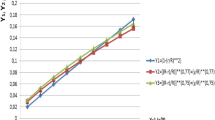Conclusion
The determinate method of calculating the correction factors in models of turbulence constructed on the basis of simulating the process of self-organization of a steady kinematic structure does not depend on the flow regime and, consequently, is in essence a new variational principle of continuum mechanics, the practical significance of which consists in that by means of it it is possible to solve precisely those problems which are not solved with the use of traditional variational principles.
Similar content being viewed by others
Literature cited
N. N. Moiseev, Mathematics Sets Up Experiment [in Russian], Nauka, Moscow (1979).
Structure of Turbulent Flow and Mechanism of Heat Exchange in Channels [in Russian], Atomizdat, Moscow (1978).
I. A. Sherekov, Applied Two-Dimensional Problems of Hydraulics of Tranquil Flows [in Russian], Énergiya, Moscow (1978).
L. S. Polak and A. S. Mykhailov, Self-Organization in Nonequilibrium Physicochemical Systems [in Russian], Nauka, Moscow (1983).
I. P. Spitsyn, “Interaction of flows of the main channel and floodplain,” Meteorol. Gidrol., No. 10 (1962).
L. D. Landau and E. M. Lifshits, Statistical Physics [in Russian], Nauka, Moscow (1964).
N. A. Slezkin, Dynamics of a Viscous Incompressible Fluid [in Russian], GITTL, Moscow (1955).
G. P. Skrebkov, “Hydraulic resistance of channels to plane flow,” Izv. VNIIG,145, (1981).
G. P. Skrebkov, “Method of calculating the distribution of velocities over the width of a weakly deformed river stretch,” Meteorol. Gidrol., No. 3 (1972).
S. N. Lozhkin, “Calculation of the hydrodynamics of turbulent flow in channels formed by cylindrical bars,” in: Hydraulics and Heat Exchange during Fluid Flow in Channels [in Russian], Chuvashskii Gos. Univ., Cheboksary (1980).
Hydrodynamics and Heat Exchange in Nuclear Power Plants (Principles of Calculation) [in Russian], Atomizdat, Moscow (1975).
G. P. Skrebkov and A. V. Pogosyan, “Characteristics of hydrodynamics of turbulent flow in square pipes,” Izv. Vyssh. Uchebn. Zaved., Ser. Énerget., No. 8 (1985).
Van M. G. Nlcollet, “Ecoulements permanents a surface libre en lits composes,” La Houllle Blanche, No. 1, 21–30 (1979).
Additional information
Translated from Gidrotekhnicheskoe Stroitel'stvo, No. 5, pp. 31–35, May, 1988.
Rights and permissions
About this article
Cite this article
Lozhkin, S.N. Calculation of the kinematic characteristics of uniform flow in canals. Hydrotechnical Construction 22, 288–294 (1988). https://doi.org/10.1007/BF01428058
Issue Date:
DOI: https://doi.org/10.1007/BF01428058




